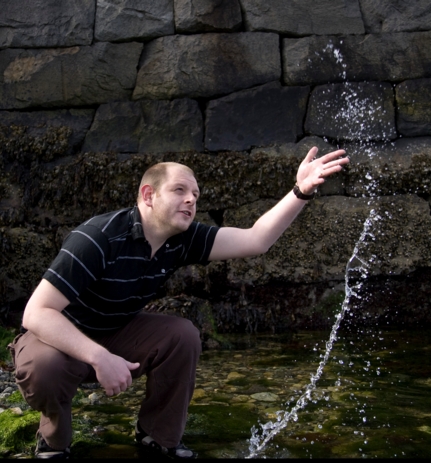Home > Press > Towards the safer use of nanoparticles
 |
| Andy Booth has initiated a new nanotechnology knowledge transfer network called SafeNano Norway, linked to health, safety and environmental issues. Photo: Thor Nielsen. |
Abstract:
What kind of HSE know-how do we really need to manage the new substances now found in everything from our clothes to cosmetics and electronics? Are nanoparticles harmful to the environment - or are these invisible particles safer than we think?
Towards the safer use of nanoparticles
Norway | Posted on June 26th, 2011These are just some of the questions to which SINTEF researcher and environmental chemist Andy Booth wants to find the answers. He has in fact initiated a new nanotechnology knowledge transfer network called SafeNano Norway, linked to health, safety and environmental issues.
"Traditionally, there has never been any close collaboration between the fields of HSE and nanotechnology, but we are now seeing a clear need for this", says Booth, who usually works as a researcher into the influence of nanoparticles on the marine environment.
He has recently been devoting much of his time establishing a network aimed at transferring knowledge and expertise between the two disciplines. As well as HSE issues, the network also addresses ethical issues linked to nanotechnology.
Oracle Service
The creation of an independent network linking the industries that manufacture, use or sell products containing nanoparticles with the research community is an important goal of the project. Booth hopes that this work will also enhance the general public's confidence in practical nanoproducts.
"We will achieve this by means of workshops and the network's own ‘Oracle Service'", says Booth. On the network's website you can put questions directly to the expert panel and get your answers free of charge. We also use the website to publish articles and research results on current topics", says Andy.
Knowledge transfer
The network is currently aiming to forge links with several member companies and organisations, both to enhance knowledge transfer, and to obtain sufficient funding for its administration and development.
"We are encouraging the industry to contact us", says Booth. The more members we have, the more knowledge will emerge and the more it will be used", he says.
As well as Sintef, the network includes the Norwegian University of Science and Technology, the University of Bergen, the Norwegian University of Life Sciences, Bioforsk, the Norwegian Institute for Water Research and the Norwegian Work Research Institute. Basic funding is provided by SINTEF Materials and Chemistry and the Research Council of Norway's NANOMAT programme.
Facts about nanoparticles: "Nanoparticle" is a general term describing more than one type of particle. There are in fact millions of potential varieties. Currently, it is impossible to know how many there are. As with chemicals, some will be toxic and others not. Natural nanoparticles can be found in soil, water and seaspray salts, and others in smoke and soot derived from combustion processes such as forest fires, welding or diesel exhaust. The third category comprise those manufactured by humans for their properties related to size or surface attributes, such as the gold nanoparticles used to destroy bacteria.
####
For more information, please click here
Contacts:
Andy Booth
SINTEF
tel.: + 47 93089510
Aase Dragland
+4773592476
Copyright © AlphaGalileo
If you have a comment, please Contact us.Issuers of news releases, not 7th Wave, Inc. or Nanotechnology Now, are solely responsible for the accuracy of the content.
| Related News Press |
News and information
![]() Researchers develop molecular qubits that communicate at telecom frequencies October 3rd, 2025
Researchers develop molecular qubits that communicate at telecom frequencies October 3rd, 2025
![]() Next-generation quantum communication October 3rd, 2025
Next-generation quantum communication October 3rd, 2025
![]() "Nanoreactor" cage uses visible light for catalytic and ultra-selective cross-cycloadditions October 3rd, 2025
"Nanoreactor" cage uses visible light for catalytic and ultra-selective cross-cycloadditions October 3rd, 2025
Announcements
![]() Rice membrane extracts lithium from brines with greater speed, less waste October 3rd, 2025
Rice membrane extracts lithium from brines with greater speed, less waste October 3rd, 2025
![]() Researchers develop molecular qubits that communicate at telecom frequencies October 3rd, 2025
Researchers develop molecular qubits that communicate at telecom frequencies October 3rd, 2025
![]() Next-generation quantum communication October 3rd, 2025
Next-generation quantum communication October 3rd, 2025
![]() "Nanoreactor" cage uses visible light for catalytic and ultra-selective cross-cycloadditions October 3rd, 2025
"Nanoreactor" cage uses visible light for catalytic and ultra-selective cross-cycloadditions October 3rd, 2025
Patents/IP/Tech Transfer/Licensing
![]() Getting drugs across the blood-brain barrier using nanoparticles March 3rd, 2023
Getting drugs across the blood-brain barrier using nanoparticles March 3rd, 2023
![]() Metasurfaces control polarized light at will: New research unlocks the hidden potential of metasurfaces August 13th, 2021
Metasurfaces control polarized light at will: New research unlocks the hidden potential of metasurfaces August 13th, 2021
![]() Arrowhead Pharmaceuticals Announces Closing of Agreement with Takeda November 27th, 2020
Arrowhead Pharmaceuticals Announces Closing of Agreement with Takeda November 27th, 2020
Safety-Nanoparticles/Risk management
![]() Onion-like nanoparticles found in aircraft exhaust May 14th, 2025
Onion-like nanoparticles found in aircraft exhaust May 14th, 2025
![]() Closing the gaps — MXene-coating filters can enhance performance and reusability February 28th, 2025
Closing the gaps — MXene-coating filters can enhance performance and reusability February 28th, 2025
|
|
||
|
|
||
| The latest news from around the world, FREE | ||
|
|
||
|
|
||
| Premium Products | ||
|
|
||
|
Only the news you want to read!
Learn More |
||
|
|
||
|
Full-service, expert consulting
Learn More |
||
|
|
||








